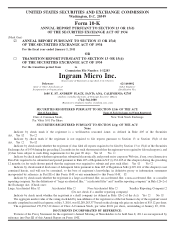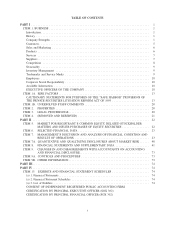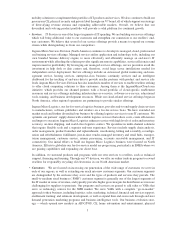Ingram Micro 2010 Annual Report Download - page 17
Download and view the complete annual report
Please find page 17 of the 2010 Ingram Micro annual report below. You can navigate through the pages in the report by either clicking on the pages listed below, or by using the keyword search tool below to find specific information within the annual report.may become areas of opportunity. There has been an accelerated movement among transportation and logistics
companies to provide many of these fulfillment and e-commerce supply chain services. Within this arena, we face
competition from major transportation and logistics suppliers such as DHL, Menlo, and UPS Supply Chain
Solutions.
The advent of cloud computing, or software-, platform- and infrastructure-as-a-service, provides another
means for suppliers to deliver technology products directly to end-users and bypass the IT distribution channel. IT
distributors are developing initiatives to remain relevant as this, and other alternative delivery models, evolve. We
have developed service offerings designed to enable resellers to offer cloud computing solutions to end-users and
will continue to refine service offerings around new delivery models.
We are constantly seeking to expand our business into areas closely related to our IT products and services
distribution business. As we enter new business areas, including value-added services, we may encounter increased
competition from current competitors and/or from new competitors, some of which may be our current customers.
Seasonality
We experience some seasonal fluctuation in demand in our business. For instance, we typically see lower
demand, particularly in Europe, in the summer months. We also normally see an increase in demand in the
September to December period, driven primarily by pre-holiday impacts on stocking levels in the retail channel and
on volume of business for our North American fee-based logistics services.
Inventory Management
We strive to maintain sufficient quantities of product inventories to achieve optimum order fill rates. Our
business, like that of other distributors, is subject to the risk that the value of our inventory will be impacted
adversely by suppliers’ price reductions or by technological changes affecting the usefulness or desirability of the
products comprising the inventory. It is the policy of many suppliers of technology products to offer distributors
limited protection from the loss in value of inventory due to technological change or a supplier’s price reductions.
When protection is offered, the distributor may be restricted to a designated period of time in which products may be
returned for credit or exchanged for other products or during which price protection credits may be claimed. We
continually take various actions, including monitoring our inventory levels and controlling the timing of purchases,
to maximize our protection under supplier programs and reduce our inventory risk. However, no assurance can be
given that current protective terms and conditions will continue or that they will adequately protect us against
declines in inventory value, or that they will not be revised in such a manner as to adversely impact our ability to
obtain price protection. In addition, suppliers may become insolvent and unable to fulfill their protection
obligations to us. We are subject to the risk that our inventory values may decline and protective terms under
supplier agreements may not adequately cover the decline in values. In addition, we distribute a small amount of
private label products for which price protection is not customarily contractually available, for which we do not
normally enjoy return rights, and for which we bear certain increased risks. We manage these risks through pricing
and continual monitoring of existing inventory levels relative to customer demand, reflecting our forecasts of future
demand and market conditions. On an ongoing basis, we reserve for excess and obsolete inventories and these
reserves are appropriately utilized for liquidation of such inventories.
Inventory levels may vary from period to period, due, in part, to differences in actual demand from that
forecasted when placing orders, the addition of new suppliers or new lines with current suppliers, expansion into
new product areas, such as AIDC/POS and CE, and strategic purchases of inventory. In addition, payment terms
with inventory suppliers may vary from time to time, and could result in fewer inventories being financed by
suppliers and a greater amount of inventory being financed by our capital. Our payment patterns can be influenced
by incentives, such as early pay discounts offered by suppliers.
Trademarks and Service Marks
We own or license various trademarks and service marks, including, among others, “Ingram Micro,” the
Ingram Micro logo, “V7” (Video Seven), “VentureTech Network,” “AVAD,” and “Vantex.” Certain of these marks
are registered, or are in the process of being registered, in the United States and various other countries. Even though
9
























